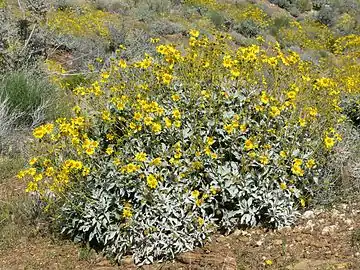Encelia farinosa
Encelia farinosa (commonly known as brittlebush, brittlebrush, or incienso), is a common desert shrub of northern Mexico (Baja California, Baja California Sur, Sonora, Sinaloa, and Hidalgo) and the southwestern United States (California, Arizona, Utah, and Nevada).[1][2][3]
| Encelia farinosa | |
|---|---|
 | |
| near Palm Springs, California | |
| Scientific classification | |
| Kingdom: | |
| (unranked): | |
| (unranked): | |
| (unranked): | |
| Order: | |
| Family: | |
| Genus: | |
| Species: | E. farinosa |
| Binomial name | |
| Encelia farinosa | |

The common name "brittlebush" comes from the brittleness of its stems. Other names include hierba del vaso (Spanish) and cotx (Seri).[4] Another Spanish name for it is incienso because the dried sap was burned by early Spanish missions in the New World as incense.
Habitat
E. farinosa can be found in a variety of habitats from dry, gravelly slopes to open, sandy washes up to 1,000 m (3,300 ft). It requires a very sunny position in a deep very well-drained soil, and minimal winter frost.[5]
It does well in cultivation often being used for border, erosion control, ground cover and massing.[6] Recently the plant has spread dramatically in areas not natural to its distribution in large part because Caltrans has begun to use it in hydroseeding.
Description
Brittlebush grows up to 30 to 150 cm (12 to 59 in) tall,[7] with fragrant leaves 3–8 centimetres (1.2–3.1 in) long, ovate to deltoid, and silvery tomentose. The capitula are 3.0–3.5 cm in diameter, with orange-yellow ray florets and yellow or purple-brown disc florets. They are arranged in loose panicles above the leafy stems fruit 3–6 mm and no pappus is visible.[1] During dry seasons the plant goes drought deciduous, shedding all of its foliage, relying on the water stored in its thick stems.[5]
3-Acetyl-6-methoxybenzaldehyde is found in the leaves of E. farinosa.[8]
Varieties
Two varieties of E. farinosa are recognized by Flora of North America.[1]
- E. f. var. farinosa – yellow disc florets
- E. f. var. phenicodonta (Blake) I.M.Johnston – purple-brown disc florets
Varieties formerly included E. f. var. radians, now regarded as a separate species E. radians Brandegee.[9]
Uses
Brittlebush has a long history of uses by indigenous and pioneer peoples.
- Glue: The resin collected from the base of the plant, yellowish to brown, can be heated and used as a glue. The O'odham and Seri use it for hafting, to hold points on arrows and harpoons.[4]
- Sealer: A different sort of resin collected from the upper stems is more gummy and generally a clear yellow. The Seri use this to seal pottery vessels.[4]
- Incense: Early Spanish friars learned that the resin made a highly fragrant incense, akin to frankincense in odor.[10]
- Gum: The Sells area Tohono O'odham children use upper stem resin as a passable chewing gum.
- Toothbrush: Oldtime cowboys used brittlebush stem as a fine toothbrush.
- Medicinal: Seri use brittlebush to treat toothache; the bark is removed, the branch heated in ashes, and then placed in the mouth to "harden" a loose tooth.[4] The Cahuilla used brittlebush to treat toothaches as well,[11] and used it as a chest pain reliever by heating the gum and applying it to the chest.[11][12]
- Waterproofing: It has been used to waterproof containers.[6]
- Varnish: It has been melted then used as a varnish.[6]

References
- Brittlebush, incienso, Encelia farinosa A.Gray ex Torrey
- http://bonap.net/MapGallery/County/Encelia%20farinosa.png
- Biota of North America Program 2014 county distribution map
- Felger, Richard Stephen; Moser, Mary Beck (1985). People of the Desert and Sea: Ethnobotany of the Seri Indians (2. print. ed.). Tucson, Ariz.: University of Arizona Press. ISBN 0816508186.
- Gacsi/Morgan, April/Steve (January 1992). Deserts of the Southwest Self Guided Tour. Riverside, California: University of California, Riverside Botanic Gardens. p. 10.
- "Encelia farinosa Brittle Bush, Brittlebush, Incienso PFAF Plant Database". www.pfaf.org. Retrieved 26 January 2019.
- Hogan, C. Michael (ed.) "Brittlebush – Encelia farinosa" at the Encyclopedia of Life. Retrieved 1 April 2013.
- Gray, Reed; Bonner, James (19 March 1948). "Structure Determination and Synthesis of a Plant Growth Inhibitor, 3-Acetyl-6-methoxybenzaldehyde, Found in the Leaves of Encelia Farinosa". Journal of the American Chemical Society. 70 (3): 1249–1253. doi:10.1021/ja01183a114. PMID 18909201.
- Bohm, Bruce A. (2009). The Geography of Phytochemical Races. Dordrecht: Springer. p. 112. ISBN 9781402090523.
- Dunmire, William W. (2004). Gardens of New Spain: How Mediterranean Plants and Foods Changed America. Austin: University of Texas Press. ISBN 978-0-292-70564-7.
- "Plants of the Cahuilla Indians of the Colorado Desert and Surrounding Mountains". Enduring Knowledge Publications. Retrieved 26 January 2019.
- James, Harry. Temalpakh: Cahuilla Indian Knowledge and Usage of Plants. Malki Museum Press. ISBN 978-0-9390-4606-5.
External links
| Wikimedia Commons has media related to Encelia farinosa. |